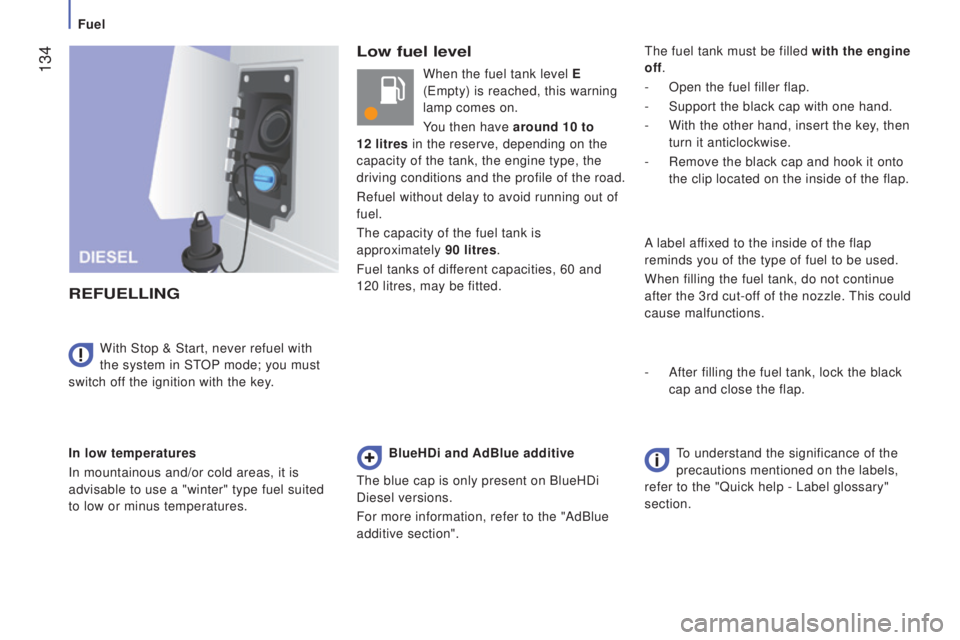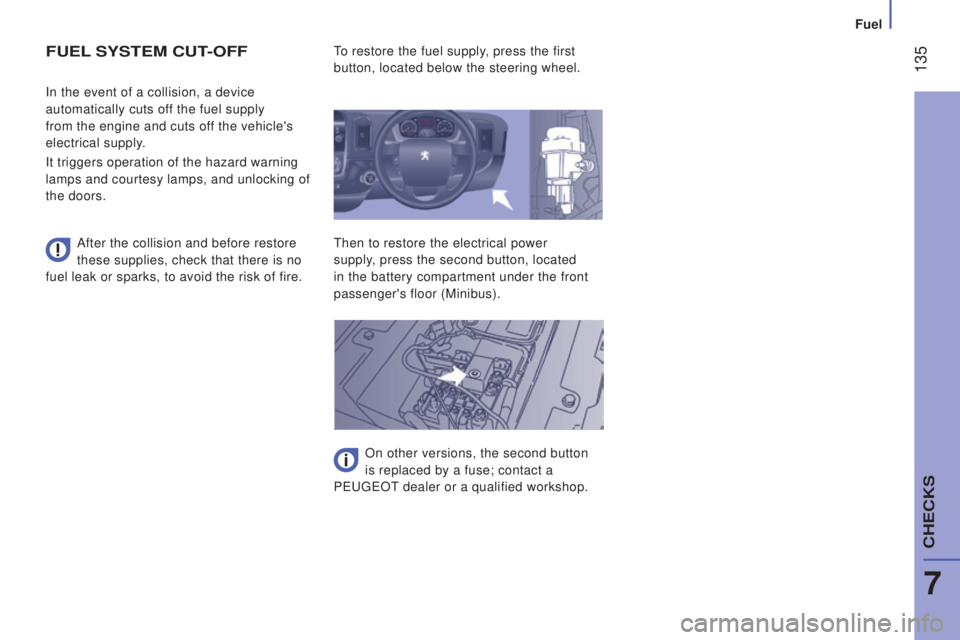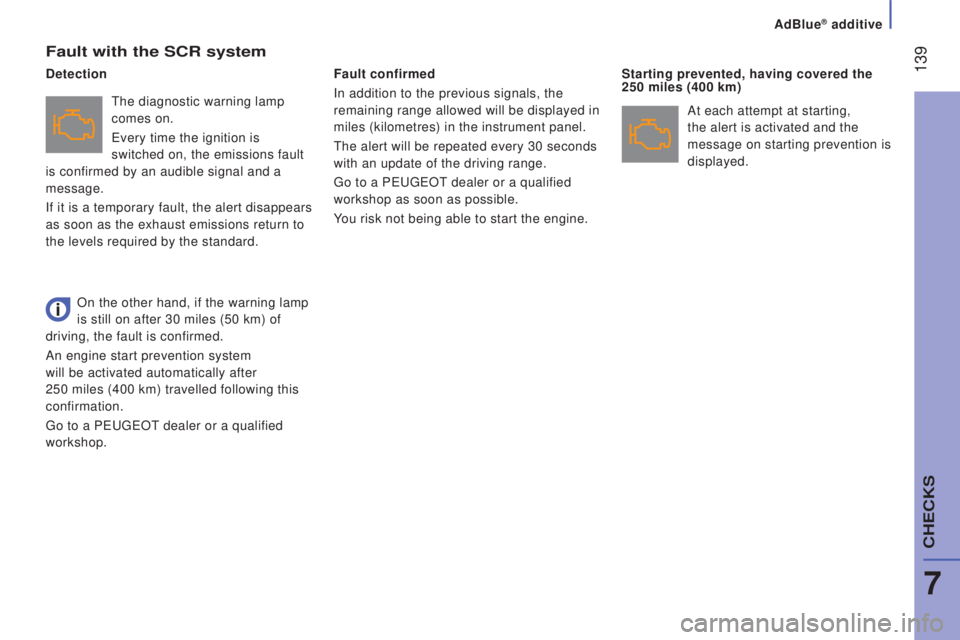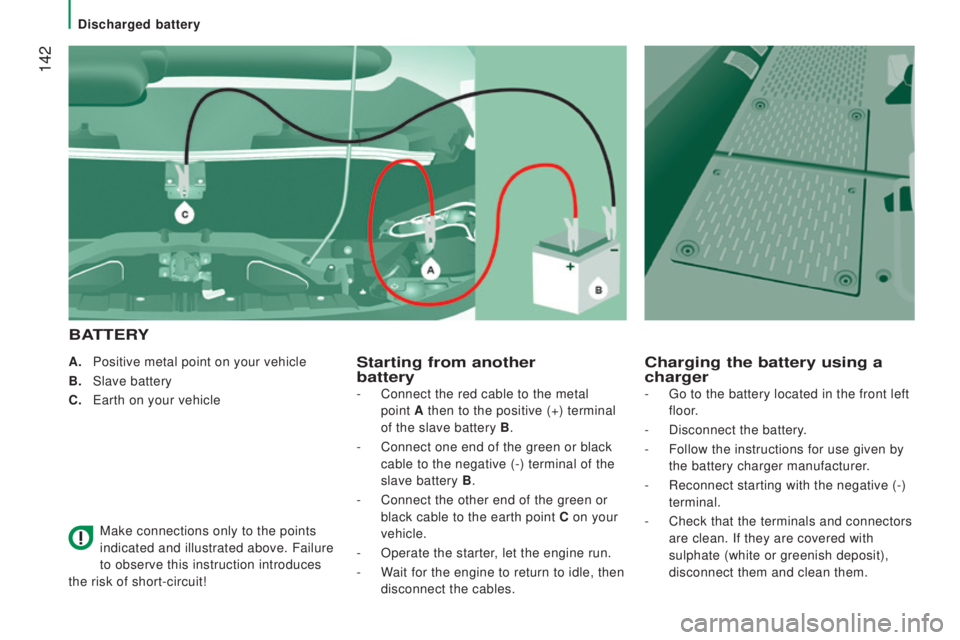2015 PEUGEOT BOXER engine
[x] Cancel search: enginePage 136 of 276

134
Low fuel level
rEFuELLInG
In low temperatures
In mountainous and/or cold areas, it is
advisable to use a "winter" type fuel suited
to low or minus temperatures.With Stop & Start, never refuel with
the system in S
tOP mode; you must
switch off the ignition with the key. When the fuel tank level E
(
empty) is reached, this warning
lamp comes on.
You then have around 10 to
12 litres in the reserve, depending on the
capacity of the tank, the engine type, the
driving conditions and the profile of the road.
Refuel without delay to avoid running out of
fuel.
the capacity of the fuel tank is
approximately 90 litres.
Fuel tanks of different capacities, 60
and
120 litres, may be fitted.
the fuel tank must be filled
with the engine
off.
-
Open the fuel filler flap.
-
Support the black cap with one hand.
-
With the other hand, insert the key, then
turn it anticlockwise.
-
Remove the black cap and hook it onto
the clip located on the inside of the flap.
A
label affixed to the inside of the flap
reminds you of the type of fuel to be used.
When filling the fuel tank, do not continue
after the 3rd cut-off of the nozzle.
this could
cause malfunctions.
-
After filling the fuel tank, lock the black
cap and close the flap.
BlueH
di and AdBlue additive
the blue cap is only present on BlueHDi
Diesel versions.
For more information, refer to the "AdBlue
additive section".to understand the significance of the
precautions mentioned on the labels,
refer to the "Quick help - Label glossary"
section.
Fuel
Page 137 of 276

135
FuEL SYStEM cut-oFF
After the collision and before restore
these supplies, check that there is no
fuel leak or sparks, to avoid the risk of fire. In the event of a collision, a device
automatically cuts off the fuel supply
from the engine and cuts off the vehicle's
electrical supply.
It triggers operation of the hazard warning
lamps and courtesy lamps, and unlocking of
the doors.
to restore the fuel supply, press the first
button, located below the steering wheel.then to restore the electrical power
supply, press the second button, located
in the battery compartment under the front
passenger's floor (Minibus).
On other versions, the second button
is replaced by a fuse; contact a
P
eugeOt dealer or a qualified workshop.
7
CHeCKS
Fuel
Page 138 of 276

136
BLuEHdI
A
nd AdBLuE® AddItIVE
AdBlue® is the brand name of the solution
needed for operation of the SCR system.
BlueHDI vehicles have a specific AdBlue
®
additive tank with a capacity of 15 litres.
It has an exterior filler located behind the
fuel filler flap below the fuel filler cap and
closed with a blue filler cap.
the objective of BlueHDi is to reduce by
up to 90% the emissions of NOx (nitrous
oxides) in the air, using a system that
converts NOx into water vapour and nitrogen
in a dedicated catalytic converter: SCR
(Selective Catalytic Reduction).
this objective meets the "euro 6" emissions
standard adopted by the
european union
aimed at limiting the emissions of pollutants
from internal combustion engines.
the SCR technology used on BlueHDi
engines involves the injection of AdBlue
®
fluid into the exhaust system.this operation can also be carried out
by a PeugeOt dealer or a qualified
workshop.
Scr technology
Filling of the AdBlue® tank can be done
using:
-
5 or 10 litres containers equipped with a
10 centimetre filler tube or the filling kit
available from P
eugeOt dealers,
-
1.89 litre botles that are screwed onto
the filler neck, available from P
eugeOt
dealers,
-
or when at a fuel filling station equipped
with a special
AdBlue
® delivery pump for
heavy or light vehicles.
AdBlue® additive
Page 140 of 276

138
range indicators
Different levels of alert are triggered
according to the remaining driving range
threshold.
You will be informed as each mileage
threshold is reached and the alerts will
change from temporary to permanent.
-
t
he 1st alert is triggered at a remaining
driving range of 1 500 miles (2 400 km).
-
t
he 2nd alert is triggered at a remaining
driving range of 375 miles (600 km).
up to 0 miles, at which point it will be
impossible to restart the engine after a stop.
range greater than 1 500 miles (2 400 km)
No information displayed.
Once the 1 500 miles (2 400 km)
threshold is reached, this warning
lamp comes on temporarily and the
remaining range message is displayed.
every time the ignition is switched on, the
alert is given, together with an audible
signal.
remaining range less than 1 500 miles
(2 400 km) and greater than 375 miles
(600 km)
Once the 350 miles (600 km) threshold
is reached, this warning lamp flashes,
accompanied by a message on the
remaining driving range.
the alert is repeated with an update of the
remaining driving range in steps of 30 miles
(50 km) travelled.
every time the ignition is switched on, the
alert is given together with an audible signal.
At 0 miles the system installed in the
vehicle to meet the emissions standard
will prevent engine starting.
the 0 level of
AdBlue
® additive has been
reached.
Your vehicle's exhaust emissions no longer
meet the "
euro 6" standard and the engine
will not start.
to be able to restart
the vehicle, you must
add at least 3.8 litres of AdBlue
®.
-
Pour the additive into the tank (by the
filler with the blue cap).
-
Switch on the ignition without starting.
-
Wait 10 seconds before starting the
engine.
remaining range less than 350 miles
(600 km) and more than 0 miles Starting prevented, breakdown related to a
lack of AdBlue
®
additive in the special tank
Avoid waiting until the remaining
range is 0 miles!
the alert is repeated when driving until the
AdBlue additive tank has been topped-up
with sufficient additive.
unless the additive in the special additive
tank is topped-up, you risk immobilisation of
the vehicle. Following this, make a further fill to the
special additive tank, the capacity of
which is 15 litres. Or go to a P
eugeOt dealer or a
qualified workshop.
AdBlue® additive
Page 141 of 276

139
Fault with the Scr system
the diagnostic warning lamp
comes on.
every time the ignition is
switched on, the emissions fault
is confirmed by an audible signal and a
message.
If it is a temporary fault, the alert disappears
as soon as the exhaust emissions return to
the levels required by the standard. Fault confirmed
In addition to the previous signals, the
remaining range allowed will be displayed in
miles (kilometres) in the instrument panel.
the alert will be repeated every 30 seconds
with an update of the driving range.
go to a PeugeOt dealer or a qualified
workshop as soon as possible.
Y
ou risk not being able to start the engine. Starting prevented, having covered the
250 miles (400 km)
detection
At each attempt at starting,
the alert is activated and the
message on starting prevention is
displayed.
On the other hand, if the warning lamp
is still on after 30 miles (50 km) of
driving, the fault is confirmed.
An engine start prevention system
will be activated automatically after
250
miles (400 km) travelled following this
confirmation.
go to a PeugeOt dealer or a qualified
workshop.
AdBlue® additive
7
CHeCKS
Page 142 of 276

140
refilling / topping-up the
AdBlue® additive
Precautions to take
use
only AdBlue® additive that meets the
ISO 22241 standard.
the AdBlue® additive is an urea-based
solution.
this liquid is non-flammable, colourless and
odourless.
to be kept in a cool area.
containers (5 or 10 litres) and bottles
(1.89 litres) of AdBlue
®
Please check the use-by date.
Read the instructions on the label.
ensure that you have a suitable filler pipe,
which may or may not be supplied with the
container. Park the vehicle
-
Before topping-up, ensure that the
vehicle is parked on a flat and level
surface.
open the filler
-
Open the fuel filler flap.
-
t
urn the blue cap a 6th of a turn anti-
clockwise.
-
Remove the blue cap downwards.
top-up
-
Obtain a bottle of AdBlue®. After first
checking the use-by date, read carefully
the instructions on use on the label
before pouring the contents of the bottle
into your vehicle's AdBlue
® tank.
Important: if your vehicle's AdBlue
®
tank is completely empty - which is
confirmed by the alert messages and the
impossibility of starting the engine, you
must add at least 3.8 litres (so two 1.89 litre
bottles).
-
After emptying the bottle, wipe away any
spillage around the tank filler using a
damp cloth.
If any additive is split or splashed,
wash immediately with cold water or
wipe with a damp cloth.
If the additive has crystallised, clean it off
using a sponge and hot water.
AdBlue® additive
Page 144 of 276

142
A. Positive metal point on your vehicle
B.
Slave battery
c.
e
arth on your vehicle
Make connections only to the points
indicated and illustrated above. Failure
to observe this instruction introduces
the risk of short-circuit!Starting from another
battery
B
AttErY
c
harging the battery using a
charger
- Connect the red cable to the metal
point
A then to the positive (+) terminal
of the slave battery
B.
-
Connect one end of the green or black
cable to the negative (-) terminal of the
slave battery B .
-
Connect the other end of the green or
black cable to the earth point
c on your
vehicle.
-
Operate the starter, let the engine run.
-
Wait for the engine to return to idle, then
disconnect the cables. -
go to the battery located in the front left
floor.
-
Disconnect the battery.
-
Follow the instructions for use given by
the battery charger manufacturer
.
-
Reconnect starting with the negative (-)
terminal.
-
Check that the terminals and connectors
are clean. If they are covered with
sulphate (white or greenish deposit),
disconnect them and clean them.
Discharged battery
Page 145 of 276

143
Access to the battery
unscrew the 6 access cover retaining
screws.
Lift off or remove completely the access
cover.
Press lever 1 downwards to spread the
clamp.
Remove the terminal 2 from the negative (-)
post.
the batteries contain harmful
substances such as sulphuric acid and
lead.
they must be discarded in accordance
with the provisions of the law and must not,
in any circumstances, be discarded with
household waste.
take used batteries to a special collection
point.
the charging operation must be carried
out in a ventilated area away from
naked flames or any possible sources of
sparks to eliminate the risk of explosion
and fire.
Do not attempt to charge a frozen battery: it
must first be thawed to eliminate the risks of
explosion. If the battery has frozen, before
charging it have it checked by a specialist
who will check that the internal components
have not been damaged and that the
container is not cracked, which could mean
that there is a risk of a leak of toxic and
corrosive acid.
Proceed with a slow charge charge at low
current for a maximum pf about 24 hours to
avoid damaging the battery. Before disconnecting the battery, you must
wait for 2 minutes after switching off the
ignition.
Never disconnect a terminal when the
engine is running.
Never charge a battery without first
disconnecting the terminals.
Close the windows and doors before
disconnecting the battery.
After every reconnection of the battery,
switch on the ignition and wait 1 minute
before starting to allow the electronic
systems to be initialised. If slight difficulties
are experienced after this, please contact a
P
eugeOt dealer or a qualified workshop.
Discharged battery
QuICK HeLP
8